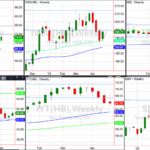
Chances for the 33-year bull run in the bond market to fall flat in 2016 increased when the Fed enacted a rate hike in December 2015 after almost a decade. But in reality, bonds kept bouncing throughout the first quarter on a low-yield environment in most developed markets across the world.
Thanks to China-led global market worries and the 12-year plunge in oil prices, the global market went berserk to start this year. All these buried risk-on sentiments and boosted relatively safer fixed-income securities in the quarter, pulling bond yields down.
In fact, the impact of the global financial market turmoil was so deep-rooted that the Fed halved its number of rate hike estimates for 2016 from four to two in its March meeting. Also, Fed chair Yellen reaffirmed a ‘cautious’ stance on future policy tightening.
Needless to say, the very move dragged down the U.S. benchmark bond yields and pushed up its prices. Notably, yields on 10-year Treasury notes dropped 41 bps to 1.83% (as of March 30, 2016) in the quarter, leading U.S. Treasury valuation to soar.
Meanwhile, deflationary threats led the central banks of Japan and Euro zone to widen their already ultra-easy monetary policies. At its January-end meeting, BoJ set its key interest rate at negative 0.1%. BoJ then hinted at further cuts in interest rates if the economy fails to improve desirably.
In Europe, the ECB president Mario Draghi turned super dovish in March by raising the monthly bond purchase size to EUR 80 billion from 60 billion previously.
Also, ECB lowered the deposit facility rate to negative 0.4%, down from the previous rate of negative 0.3%. It also cut its main refinancing rate and marginal lending rates by 0.5% each to zero percent and 0.25%, respectively (read: Surprise ETF Winners & Losers Post ECB Easing).
Quite expectedly, the twin boosters of easy money policy globally and a delayed rate hike in the U.S. made fixed-income securities a winner in the first quarter. It would thus be interesting to note the ETFs that were the leaders in the bond space during the quarter. Returns are as per xtf.com.
25+ Year Zero Coupon U.S. Treasury Index Fund (ZROZ)
ZROZ follows the BofA Merrill Lynch Long US Treasury Principal STRIPS Index, which focuses on Treasury principal STRIPS that have 25 years or more remaining to final maturity. It charges just 15 basis points in expenses while the 30-day SEC yield is 2.62% currently (as of March 29, 2016). ZROZ has added 14.3% so far this year (as of March 30, 2016). The fund has a Zacks ETF Rank #2 (Buy) with a High risk outlook (read: 5 ETFs for Portfolio Safety, Stability and Diversification).
DB German Bund Futures ETN (BUNL)
German bonds and the related ETFs also made an impressive rebound as these offer safety.Following extremely lower yields due to accommodative ECB policies, “German government bond yields are set to record their biggest quarterly fall in 4-1/2 years” on March 31, 2016.
The note looks to provide investors exposure to the U.S. dollar value of the returns of a German bond futures index, replicating the performance of a long position in Euro-Bund Futures. The note is up 14.3% so far this year (as of March 30, 2016).
Vanguard Extended Duration Treasury ETF (EDV)
The fund seeks to match the performance of the Barclays U.S. Treasury STRIPS 20-30 Year Equal Par Bond Index. This means that this benchmark zeroes in on fixed income securities that are sold at a discount to face value, and then the investor is paid the face value upon maturity (read: Extended Duration ETFs Head to Head: EDV vs ZROZ).
The fund charges 10 bps in fees. This Zacks Rank #2 ETF yields 2.71% annually. The fund has returned 13% so far this year (as of March 30, 2016).
DB Japanese Govt Bond Futures ETN (JGBL)
Very low bond yields following Bank of Japan’s decision to push key interest rates to the negative territory to engineer the sagging economy were behind JGBL’s surge. Many analysts are of the view that “negative bond yields are here to stay in 2016” for Japanese bonds.
The product looks to track the DB USD JGB Futures Index, which is intended to measure the performance of a long position in 10-year JGB Futures. JGBL advanced about 9.9% so far this year (as of March 30, 2016).
PIMCO 15+ Year US TIPS ETF (LTPZ – ETF report)
The fund tracks the BofA Merrill Lynch 15+ Year US Inflation-Linked Treasury Index and is up 9.6% so far this year (as of March 30, 2016). As U.S. inflation improved in the quarter, TIPS ETFs came into the limelight (read: Do TIPS ETFs Deserve a Look as Inflation Rises?).












